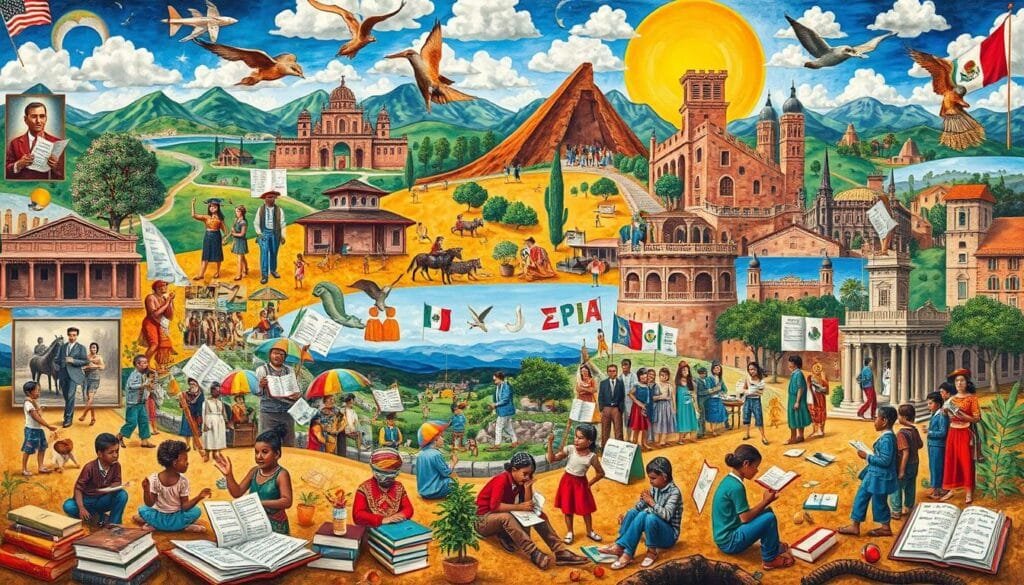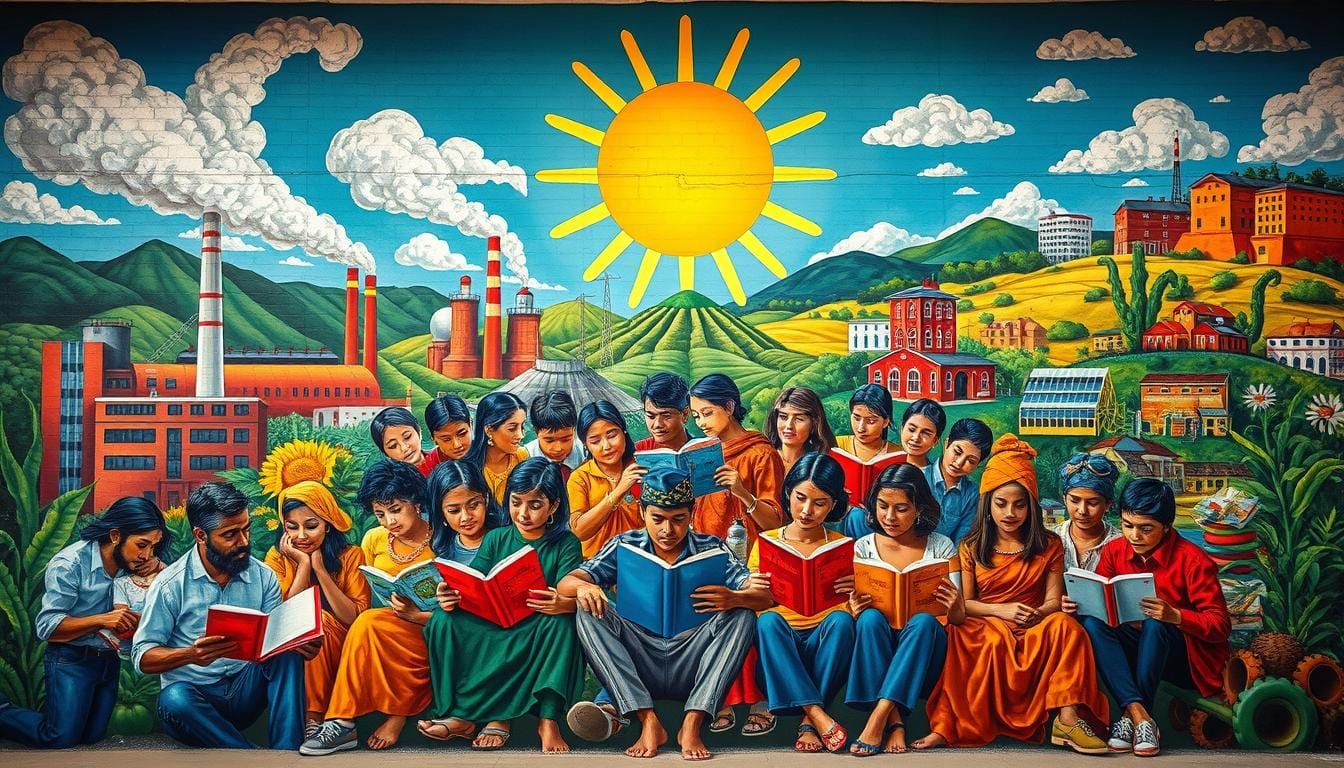Mexico’s economic growth relies on many factors. One key factor is literacy. It does more than just help people read and write. It leads to economic success through a well-educated workforce. This workforce can innovate and make smart money decisions. Financial learning is crucial for this. It helps include more people in society’s benefits of growing economically.
However, Mexico faces challenges despite improving access to credit. These challenges slow down its path to continued economic advancement. It is vital for government and private organizations to work together. They must raise the bar for financial learning. The OECD in 2017 ranked Mexico 12th among G20 countries in financial education. This shows the need for better financial service understanding. Without it, Mexico cannot achieve true social and economic inclusion.
Key Takeaways
- Enhancing Mexico’s economic growth requires addressing the fundamental role of literacy within the country.
- There is a direct correlation between literacy, particularly financial education, and the ability to participate fully in México’s economy.
- Financial literacy is critical to narrowing economic disparities and promoting social inclusion in Mexico.
- Collaborative efforts from public and private sectors are essential to improve Mexico’s financial literacy rates.
- Current OECD rankings highlight the urgency for Mexico to elevate its financial education to align with other G20 countries.
Understanding Literacy and Economic Development in Mexico
Literacy in Mexico greatly shapes its economic growth. Improving literacy rates helps create a diverse and resilient economy. We’ll look at how literacy levels affect the economy and workforce efficiency.
The State of Literacy in Mexico
Mexico’s literacy rate is around 94%, showing progress. But, this doesn’t capture the whole picture. Places like Mexico City are far ahead of rural areas such as Chiapas and Oaxaca in literacy.
The gap in literacy levels across regions shows we need to focus on education for all. This is key to improving the economy and job effectiveness. Some areas match developed countries in literacy, while others lag behind, affecting economic growth.
Correlation Between Literacy and Economic Growth
Literacy doesn’t just benefit individuals; it sparks economic growth. It’s tied to jobs, innovation, and business expansion. High literacy areas tend to have stronger economies.
Regions with more education show greater productivity. This means boosting literacy can directly improve Mexico’s economy. It makes the workforce more skilled and innovative.
Better literacy leads to a more efficient, adaptable workforce. This is vital for Mexico to stand out globally. Improving education can lift living standards for everyone. Focused initiatives are crucial for this progress.
Literacy is more than just reading and writing. It includes financial and digital skills needed today. Investing in broad literacy can drive Mexico’s economy forward. Education is key to economic growth and fairness.
How does literacy rate affect Mexico’s country economic development
Literacy means more than just reading and writing. It is key for economic success worldwide. In Mexico, higher literacy rates boost the economy. They open up more jobs and business opportunities.
The Impact on Employment Opportunities
The literacy rate has changed Mexico’s job market a lot. A smart workforce is necessary in today’s economy, needing literacy for good jobs. This helps people move up economically.
Since 1990, more people in Mexico are going to school. This has led to more skilled jobs. It makes the economy stronger and grows stability.
Fostering Entrepreneurship and Innovation
Literacy helps entrepreneurs start and improve businesses in Mexico. It leads to more jobs and a stronger economy. New industries show how innovative Mexico is becoming.
Working to raise literacy rates is key for Mexico’s global standing. It builds a strong base for ongoing economic growth. This ensures the whole country benefits from literacy.
Literacy is making a big difference in Mexico. It helps people do better economically. By improving literacy, we’re not just helping individuals. We’re boosting the whole country’s future.
Historical Perspective on Literacy Efforts in Mexico
Looking at history of literacy in Mexico, we see many ups and downs. The country has worked hard to make education better for everyone. However, not everyone has had the same chance to learn. This has been especially true in cities compared to the countryside.
The growth of education in Mexico has been shaped by many factors. For example, government programs have helped more people learn to read and write. This was an important step in the country’s financial education evolution.

A key focus has been improving reading and writing for both young people and adults. This is vital for growing the economy in a healthy way. Education reforms have aimed to help those who are often left out, like people in indigenous communities and areas with less money.
But there are still big challenges. Data shows that not everyone is benefiting equally from education efforts. This shows we need policies that really reach those who need them most.
| Year | Literacy Rate (%) | Educational Initiatives |
|---|---|---|
| 2000 | 85.6 | Introduction of basic literacy programs |
| 2014 | 92.8 | National Crusade Against Illiteracy |
| 2018 | 94.5 | Enhanced focus on bilingual education for indigenous communities |
| 2022 | 95.3 | Implementation of digital literacy platforms |
Understanding the history of literacy in Mexico shows both progress and remaining obstacles. It’s a story of moving forward but also facing ongoing issues. This history is key to making better plans for the future.
As we look at the past of education reform in Mexico, the role of both the government and NGOs becomes clear. They must work together on new, flexible education models. These models must meet current and future needs effectively.
The Role of Financial Education in Enhancing Literacy
Financial education and literacy rates in Mexico share a tight link. A large part of the population struggles with financial access. Improving financial education is essential. It helps people understand how to handle money. This creates a society where the economy grows because everyone is included.
Improving Access to Financial Services
About 52.9% of Mexicans don’t use banking services. This shows the need to make financial services easier to get. Improving financial access is urgent. Almost 45% think they don’t make enough to use financial products. Teaching people about these services can help close this gap.
Case Study: Banco Azteca’s “Aprende & Crece” Program
Banco Azteca’s “Aprende & Crece” is a powerful example of what education can do. It reaches out to rural areas and cities where help is needed most. In 2023, over 400,000 people learned how to manage their money better thanks to this program.

| Financial Indicator | Percentage | Insight |
|---|---|---|
| Population with No Bank Relationship | 52.9% | High potential for basic financial services introduction |
| Informal Savers | 47.5% | Need for secure, formal saving mechanisms |
| Perceived Income Insufficiency | 44.9% | Opportunity for micro-financing and credit education |
| Consumers Usually Paying Interest | 48.78% | Need for credit management education |
| Income Increase After Financial Education | 86.2% | Clear benefit of financial education on earnings |
The “Aprende & Crece” program by Banco Azteca is a model for success. It shows how the right knowledge encourages people to join the financial world. These methods improve financial understanding. They are crucial for financial education in Mexico. They show how other programs can follow their lead.
Investing in Education for Long-term Prosperity
Exploring the link between education and Mexico’s growth shows how crucial reforms are. These changes are necessary for long-term success. When done right, they can majorly boost the economy.
Educational Reforms and Their Economic Impacts
Mexico must reform education to overcome future challenges. The country’s complex laws and lack of investment are big problems. Reforming education can improve incomes and jobs, as seen in other growing economies.
Improving education access and quality is key. Mexico can then develop a workforce ready for global challenges. Raising skills in math and reading is critical. Small skill upgrades can lead to better pay. Programs like the World Bank’s could help Mexico achieve this.
Public and Private Partnerships in Education
Partnerships between public and private sectors are vital for educational progress. They bring the money and new ideas needed to improve Mexico’s education. This helps overcome the problem of not enough government funding.
In tough areas, these partnerships are even more important. They ensure more people get a good education. For example, learning from successful global educational reforms can guide Mexico.

Investing in education, making economic reforms, and creating partnerships are key for Mexico’s future. As the country faces big changes, focusing on education is crucial. This approach is necessary for Mexico to grow and become stronger.
Literacy, Technology, and the Digital Divide in Mexico
In Mexico, the digital divide is a big challenge. It’s about more than just getting online. It involves technology literacy and access to tech. To really make a difference, we need a plan that boosts tech use and economic growth. Improving technology literacy can help close the gap. This could also make it easier for people to overcome economic hurdles.
So far, a lot of effort has been on improving tech infrastructure. But, it’s also key to help everyone learn to use digital tools well. Research links digital know-how with more chances in the digital economy. That’s why education should cover tech skills alongside reading and writing.
- In the last 20 years, Mexico’s internet users jumped from 5 million to 86 million. Yet, not everyone has the same access, especially when comparing cities to rural places.
- The e-Mexico initiative aimed to get more rural areas online by setting up telecenters. But, mixed results due to tough challenges highlight the work still needed.
- Places with better internet often see more business activity. This shows how tech access and know-how can drive economic growth.
Making Mexico digitally advanced does more than connect people. It starts a cycle of empowerment and brings big benefits to society. It happens when citizens get the digital skills they need.
| Year | Internet Users | Total Population |
|---|---|---|
| 2000 | 5 million | 100 million |
| 2020 | 86 million | 126 million |
The numbers tell a clear story. We need plans that focus on tech and on teaching people how to use it. Sure, tech itself is important. But, so is helping everyone get the skills to take part in the digital world. This is how we make sure tech benefits everyone.
To truly address Mexico’s digital divide, we need a two-part plan. First, build better infrastructure. And second, create a learning system that focuses on digital skills. This dual focus will help spread internet use. It will also ensure people can take full advantage of being online. This is the path to a society where everyone can grow together.
The Ripple Effect: Literacy’s Impact Beyond Economics
Literacy does more than just help the economy. It touches key parts of society like healthcare and social bonding. By improving literacy, we start a ripple effect. It strengthens not just the economy but the whole society too.
Healthcare and Literacy
Healthcare through literacy shows a strong link. People who can read understand health information better. This leads to smarter health choices. Good health choices help not just one person but entire communities. It helps Mexico become more socially inclusive by improving overall well-being.
Social Inclusion through Literacy
Literacy is crucial for Mexico’s social inclusion. It reduces social gaps. People in literate communities take part more in society and democracy. This makes society more inclusive. So, improving literacy is key to a society that sticks together.
Looking at literacy’s social role shows its wide benefits. It helps people understand healthcare, supports equality, and boosts civic participation. Literacy is vital for lasting social and economic growth. It creates the right conditions for such growth.
| Impact Area | Description | Benefits |
|---|---|---|
| Healthcare | Improved comprehension of health information | Higher quality of life, reduced healthcare costs |
| Social Inclusion | Enhanced participation in civic and community activities | More democratic and equitable society |
| Economic Stability | Increased employment opportunities | Reduction in poverty and economic disparities |
Grasping the many sides of literacy and its societal gains helps us see its full benefits. It goes beyond the economy to offer vast social perks for Mexico. This shows why literacy is so important. It’s the foundation for a healthier, more welcoming, and fair society.
Conclusion
We’ve looked closely at how important literacy is for Mexico’s economic growth. Shocking data from Chiapanec areas show a high illiteracy rate among indigenous speakers, 55.24%. This is a big issue, as most illiterate people come from developing countries and two-thirds are women. This shows we need focused literacy programs.
Financial education, like Banco Azteca’s “Aprende & Crece” program, shows how literacy helps. It makes citizens smart about money and helps the local economy. Literate people can also keep up with new technologies, improving the country’s wealth. By improving literacy, we help in many ways, like increasing jobs and empowering those who are left out.
Indigenous-centered education programs show we care about both cultural heritage and community development. Literacy is more than reading and writing. It helps reduce poverty, improve health, and create jobs. This leads us to a fair society and strong economic growth. So, investing in literacy means building a better future for Mexico.
FAQ
What is the role of literacy in Mexico’s economic development?
Literacy is key in Mexico’s economic growth. It enhances access to financial services. It also improves how people manage financial products. This boosts social inclusion. Literate people can make smart decisions and manage resources well. This helps the economy grow and reduces inequality.
How does financial literacy impact Mexico’s workforce efficiency?
Financial literacy boosts Mexico’s workforce efficiency. It teaches people to be more productive and innovative. This creates new job sectors and raises income levels for those who are financially savvy.
Can literacy rates influence employment opportunities in Mexico?
Yes, they can. People with good literacy skills are more likely to find diverse jobs. This helps improve Mexico’s economic prosperity and lifts people’s economic status.
What has been the historical approach to literacy improvement in Mexico?
Mexico has included financial education in its curriculum for better literacy. It focuses on managing household finances and using credit wisely. But, we still need gradual progress for real economic growth impact.
How does financial education improve access to financial services?
It teaches people to use financial services wisely. Programs like “Aprende & Crece” by Banco Azteca help, especially in rural areas. They make it easier for people to save money and participate in the financial system. This strengthens the economy.
What is the significance of public and private partnerships in education?
These partnerships combine the strengths of both sectors. They drive innovation and inclusive growth. By working together, they address financial literacy needs and help build a strong economic future for Mexico.
How does the digital divide affect Mexico’s economic growth?
The digital divide slows down economic progress. It keeps people from accessing vital technology. Improving digital literacy is essential for reducing gaps in the economy. It supports broader economic progress in Mexico.
In what ways does literacy contribute to healthcare and social inclusion in Mexico?
Literacy teaches people about health, leading to better health outcomes. It supports wider participation in society. Literate communities contribute to a more stable and inclusive society.
